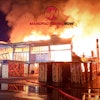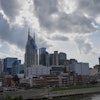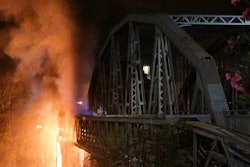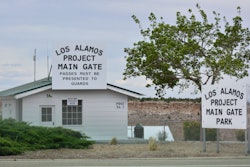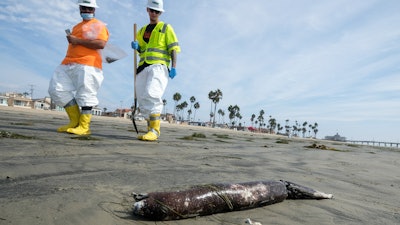
HUNTINGTON BEACH, Calif. (AP) — An underwater oil pipeline off the Southern California coast was likely damaged by a ship’s anchor several months to a year before it ruptured and sent oil spewing into the ocean and then onto some of the area’s best-known beaches, investigators said Friday.
Coast Guard Capt. Jason Neubauer, chief of the office of investigations and analysis, said after the first strike it’s possible other ships’ anchors subsequently struck the steel pipe that brings oil to shore from three platforms out at sea. Investigators previously said a large section of the pipe was bowed after being struck and dragged along the seabed.
It remains unknown when the slender, 13-inch (33-centimeter) crack began leaking oil, and investigators will pore over a year of data on ship movements near the area of the break. No ships have been identified as suspects at this point.
“We’re going to be looking at every vessel movement over that pipeline, and every close encroachment from the anchorages for the entire course of the year,” Neubauer said.
The accident scene is outside the Long Beach-Los Angeles port complex that is the largest in the country and handles some 4,000 vessels a year. Many of them are from overseas and that could complicate the process of boarding ships of interest in the investigation to get information.
The disclosure that the damage to the pipe could have occurred so long ago dramatically reshaped what was known about the leak that sent tens of thousands of gallons of crude into the Pacific. A search that initially appeared to focus on the hunt for one vessel now could send investigators to ports around the country to inspect many ships.
It now appears many factors played a role in the pipe’s failure – possible repeated anchor strikes, stresses from being dragged along the seafloor and the corrosive forces of seawater.
Neubauer said investigators have narrowed their search to large cargo vessels that would be powerful enough to move a 4,000-foot (1,219-meter) section of pipeline 105 feet (32 meters) across the ocean floor. He also said investigators have zeroed in on a windy storm Jan. 24-25 that could have caused problems for ships trying to anchor in the vicinity of the twin ports.
Investigators believe the initial anchor strike occurred sometime after a survey of the pipeline a year ago that showed the line was in its original location. The extended timeline was partly based on visible marine growth on the damaged length of the pipe that was revealed in an underwater survey. The Coast Guard previously released vide of the rupture spot and a wider view of the bowed pipe.
A crack suggests the pipe, which was installed in 1980, perhaps withstood an initial impact, but had been weakened over time by corrosion and became more prone to fail, said Ramanan Krishnamoorti, a petroleum engineering professor at the University of Houston.
Neubauer said a debris field is visible on the seafloor near the break. Investigators will now remove that section of the pipe for lab analysis. It wasn’t clear how long the investigation would take.
So far, the impact on wildfire has been minimal — 10 dead birds and another 25 recovered alive and treated — but environmentalists caution the long-term impacts could be much greater. As cleanup continued on the shore and some beaches reopened Friday, though the public still can’t go in the water.
Anchor strikes on pipelines are relatively rare, but have caused problems in the past.
An Associated Press review of more than 10,000 reports submitted to federal regulators found at least 17 accidents on pipelines carrying crude oil or other hazardous liquids have been linked to anchor strikes or suspected anchor strikes since 1986.
According to federal records, in some cases an anchor strike is never conclusively proven, such as 2012 leak from an ExxonMobil pipeline in Louisiana’s shallow Barataria Bay, where a direct strike by a barge or other boat also were considered possibilities.
In others the evidence of an anchor strike was obvious. During 1992’s Hurricane Andrew, a 30,000-pound (13,607-kilogram) anchor was dragged by a drifting drilling rig over a Texaco pipeline in the Gulf of Mexico, causing a dent that broke open when the line was later re-started.
In 2003, a 7,000-pound (3,175-kilogram) anchor was found about 10 feet (30 meters) from a small spill on a Shell Oil pipeline in the Gulf.
Capt. Morgan McManus, who spent 20 years at sea before taking command of the training ship at the State University of New York Maritime College, said he would find it difficult to believe any competent crew would drop anchor close to a pipeline. If a ship’s anchor were to become entangled with a piece of infrastructure, the operator is required by federal law to notify the Coast Guard.
“That would be a big screw-up,” McManus said. “I kind of have trouble believing that would happen because you notice that stuff on electronic charts. You’re going to map out your position where you’re going to drop the hook.”
McManus said a more likely scenario is that a ship was either pulled off position by strong waves or tides, dragging its anchor with it and snagging the pipeline. A second possibility is that ship getting underway engaged its engines while still reeling in its anchor, pulling it along the seafloor.
The leak was discovered Saturday morning, more than 12 hours after initial reports of a possible spill came in. While the exact size isn’t known, the Coast Guard slightly revised the parameters of the estimates to at least about 25,000 gallons (95,000 liters) and no more than 132,000 gallons (500,000 liters).
The Coast Guard said about 5,500 gallons (20,819 liters) of crude have been recovered from the ocean. The oil has spread southeast along the coast with reports of small amounts coming ashore in San Diego County, some 50 miles (80 kilometers) from the original site.
Amplify Energy, a Houston-based company that owns and operates three offshore oil platforms and the pipeline, said it didn’t know there had been a spill until its workers detected an oil sheen on the water Saturday at 8:09 a.m. The leak occurred about 5 miles (8 kilometers) offshore at a depth of about 98 feet (30 meters), investigators said.
Questions remain about when the company knew it had a problem and a potential delay in reporting the spill.
A foreign ship anchored in the waters off Huntington Beach reported to the Coast Guard that it saw a sheen longer than 2 miles (3 kilometers) just after 6 p.m. on Oct. 1, and that evening a satellite image from the European Space Agency also indicated a likely oil slick, which was reported to the Coast Guard at 2:06 a.m. Saturday, after being reviewed by a National Oceanic and Atmospheric Administration analyst.
Federal pipeline safety regulators have put the time of the incident at 2:30 a.m. Saturday but say the company didn’t shut down the pipeline until 6:01 a.m. — more than three hours after a low-pressure alarm had gone off indicating a possible problem — and didn’t report the leak to the Coast Guard until 9:07 a.m. Federal and state rules require immediate notification of spills.
Amplify said the line already had been shut down by 6 a.m., then restarted for five minutes for a “meter reading” and again shut down. A meter reading shows how much oil is flowing into and out of the line. The company could have been using that information to confirm if the pressure-change alarm was set off because the line was leaking, said Richard Kuprewicz, a private pipeline accident investigator and consultant.

